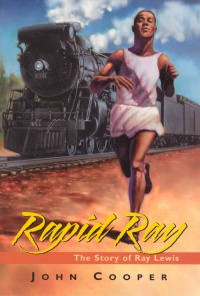| ________________
CM . . .
. Volume XI Number 2 . . . . September 17, 2004
excerpt:
In this Olympic year, it is interesting not only to watch and cheer on current champions but also to learn about the athletic achievements of past Canadian sporting heroes. Ray Lewis, the grandson of slaves, was a track superstar who went from winning his high school events in Hamilton, Ontario, to winning medals at the 1932 Olympic Games in Los Angeles and the 1934 British Empire Games (now the Commonwealth Games) in London, England. Lewis's story is riveting for any sports enthusiast. Through interviewer and author John Cooper, he talks of the enormous challenges faced by the athletes of his time vis-a-vis their modern counterparts. Coaching was limited at best, and personal trainers, massage therapists, managers and others now found in every professional athlete's life were non-existent. The tracks, themselves, were primitive in comparison to those used now: cinder tracks outside and wooden tracks for indoor events. In fact, much of Lewis's training was simply running beside the railroad tracks when his job as a porter allowed him the time! In his day, even the apparel of the runner was different; cotton shorts and sleeveless tank tops were all most athletes could afford. And Lewis refers to owning only two pairs of track shoes - longer spikes for outdoor running and pin-size spikes for indoor meets. Aside from the amazing sporting recollections, Lewis's story is as much a tale about growing up black as about being an athlete. He was the first Canadian-born black man named to an Olympic track-and-field team. The obstacles of bias and prejudice he encountered, and eventually overcame, were enormous. His stories of prejudice date from his early days in elementary school and, sadly, continue throughout most of his life. Socially he wasn't accepted and was left out of events in his school or neighbourhood and was unable to find a job. The fact that he reached his twenties just as the Depression began only made matters worse. Cooper's book could be used in a variety of ways and could serve a variety of interests. There is the sports story of how hard work and dedication lead to the Olympic podium. Lewis's recollections also touch on many of the major historical events of the first half of the twentieth century. And lastly, it would be an excellent addition to a unit on black history in Canada since the colour of his skin impacted so strongly on what Lewis was allowed to do and the person he eventually became. The book is an easy read with no really difficult or technical vocabulary. Chapters are short and arranged chronologically. There are eight pages of black and white photographs which begin circa World War I and end in 2001 when Lewis was awarded the Order of Canada. At the end of the book is a comprehensive index. This inexpensive book will have wide appeal to students interested in sports, in biographies of Canadian heroes, in social culture or in black history. Highly Recommended. Ann Ketcheson, a former teacher of high school English and French, is currently the
To comment
on this title or this review, send mail to cm@umanitoba.ca.
Copyright © the Manitoba Library Association. Reproduction for personal
use is permitted only if this copyright notice is maintained. Any
other reproduction is prohibited without permission.
NEXT REVIEW |TABLE OF CONTENTS FOR THIS ISSUE
- September 17, 2004.
AUTHORS
| TITLES | MEDIA REVIEWS
| PROFILES
| BACK ISSUES
| SEARCH | CMARCHIVE
| HOME |
